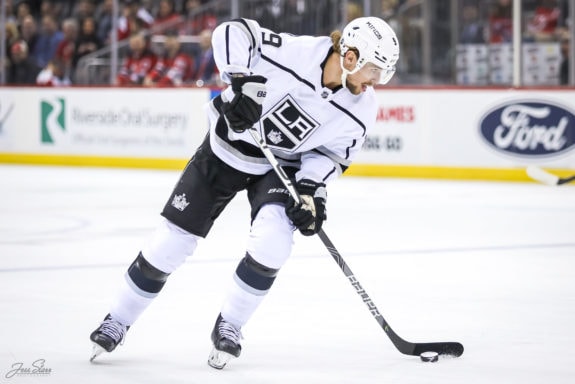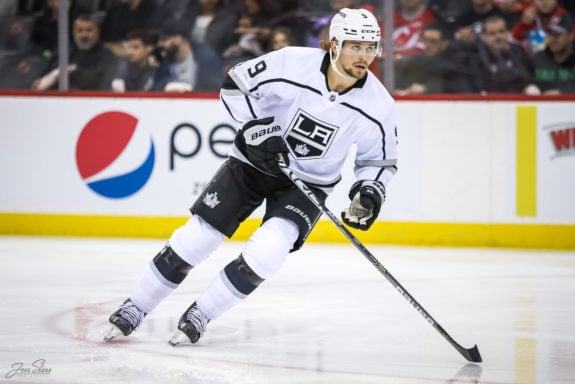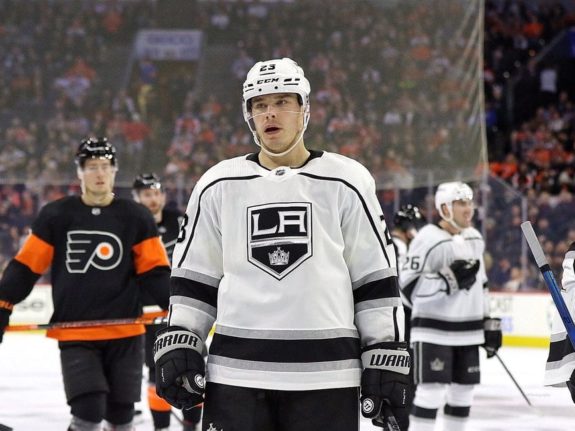With his goal on Monday night against the New York Rangers, Los Angeles Kings forward Adrian Kempe tied his previous career-high of 16 goals in a season and set himself on pace for 36 goals this season. At 25 years old, and seven years post draft, Kempe is finally having his breakout season, becoming the dominant offensive force everyone knew he could be. Still, there are worries that this incredible season is not repeatable, and this is a case of a player improving his play during a contract season, only to fall off after securing a big deal. Those concerned about this should not worry, and here’s why.
Consistent Usage
A big reason for Kempe’s improved play this season comes down to him finally getting used in a consistent role. Since breaking into the league in 2016-17, he has been moved up and down the lineup and used in several different positions. Drafted as a center, the team has finally committed to him as a full-time winger. The transition began last season, with him playing most games at wing, but this season he has exclusively played there. This move has been huge for him, as he lacks the defensive solidity to play center, and playing wing allows him to better take advantage of his size and speed. The Kings have become a more rush-focused team this season, and Kempe on the wing fits that style perfectly.

Outside of his position, his role on the team has also been more consistent this year. In previous years, he has been moved up and down the lineup constantly, rarely getting the chance to develop chemistry with linemates or familiarity with his role. This has also changed, he has played exclusively in the top-six this season, starting the year on the second line, before earning a promotion to the top line with Anze Kopitar. Expecting a player to provide consistent production without providing a consistent role for him was always unfair to Kempe, and the Kings are now reaping the benefits of utilizing him properly.
What the Numbers Say About Kempe
One of the first things you think of when seeing a player drastically improve their goal output in one season is that he must be defying the odds statistically. As an example, Anaheim Ducks forward Troy Terry is having a breakout goal-scoring campaign, but is shooting at an unsustainable 24.4%. This isn’t to say what Terry is doing is not impressive, or that he won’t continue to produce great numbers, but you can certainly expect him to see a decrease in his shooting percentage. This isn’t the case with Kempe though, he is shooting at an impressive, but not unsustainable, 15% right now. This is four points above his career average of 11%, but even if he dropped closer to his career average, let’s say split the difference and bring him to 13%, he’d still be on pace for 30-goals.
Related: Kings Getting Underrated Contributions From Adrian Kempe
Another concern would be a player who is drastically overperforming their expected goals. To use Terry as an example again, he has 9.8 goals above expected this season, while Kempe has just 2.8. Heavily outperforming your expected goals total is sustainable for some of the league’s elite scorers like Alex Ovechkin or Auston Matthews, but Kempe is not in that category, so seeing him perform close to his expected goals number is a good sign that what he’s doing is sustainable.

Despite his prolific goal scoring this season, a fair criticism of Kempe is his lack of assists, he currently has just six assists this season, and only one primary assist. This number seemed very low to me considering his ability to generate offense this season, so I did some digging. What I found is that, yes, Kempe could improve his playmaking, but he’s also been let down by poor finishing around him. His most consistent linemates this season have been, Anze Kopitar, Phillip Danault, Alex Iafallo, Dustin Brown, and Viktor Arvidsson. Of those five players, the best shooter has been Iafallo with a shooting percentage of 10% and 10 goals. While Brown and Arvidsson have abysmally low 5.1 and 7.5 shooting percentages, even worse when you realize Arvidsson was close to 6.0% when he was moved off Kempe’s line.

According to NaturalStatTrick.com, Kempe’s team on-ice shooting percentage is a fairly low 8.27%, furthering the idea that poor finishing from linemates has negatively impacted his assists numbers. It’s not like Kempe is struggling to create chances either, according to AllThreeZones.com, Kempe is posting 10.47 primary shot assists per 60, good for fifth on the team, meaning his passes are leading directly to shots on goal.
Perhaps most importantly, Kempe is second on the team for high-danger shot assists per 60 with 1.905, meaning he is setting teammates up in high-danger scoring areas more than anyone except Iafallo. Other players around him in this stat include Sam Reinhart, Trevor Zegras, and William Nylander, all of whom are prolific passers. This isn’t to say that better finishing from linemates would turn Kempe into an elite playmaker, it wouldn’t, but he would have more than just six assists and would be on pace for closer to 60-points.
Before anyone jumps on me, I will point out Kempe’s flaws as well. He is a defensive liability at times, and still needs significant work on his discipline. Despite poor finishing harming his assist totals, he still has deficiencies in his playmaking. He is far from a perfect player, and still needs work in some areas, but realistically, if he’s scoring 30 goals, most of his shortcomings can be forgiven.
Kempe is Proof That Patience Can Pay Off
With the Kings currently boasting one of the best prospect pools in the league, Kempe is a perfect example of how patience with a prospect can pay off. Very few players are truly elite point producers in their early twenties and it takes time to develop offense at the NHL level. As hockey analyst Jack Fraser, better known as JFresh, pointed out in a recent tweet, players don’t score loads of goals at a young age, and production from young players is actually decreasing.
So, while it can be frustrating to watch young players struggle to transition the offense they’ve found at lower levels into the NHL right away, don’t give up on them too easily. It’s okay if Arthur Kaliyev isn’t a 30-goal scorer next season, and don’t give up on Quinton Byfield if he isn’t a point-per-game player in 12 months. Kempe is proof that players can reach new offensive heights into their mid-twenties, and that trend holds true league-wide. One player I hope fans develop more patience for soon is Rasmus Kupari, I’ve seen plenty of fans vent frustration about the young forward recently, not without reason, but I would urge fans to give Kupari the time he needs to develop. Something I’ve thought about for a while, and TheFourthPeriod’s Dennis Bernstein has mentioned on Twitter, are the parallels between Kupari and Kempe.
I also won’t begin on the need to show patience for Gabe Vilardi today. If you are ever finding yourself getting angry at a young player for not producing, please think about what is happening with Kempe currently.
Kings Should Have no Reservations in Re-Signing Kempe
Back to Kempe, I understand fans’ concerns that he will regress back to the player who takes a ton of offensive zone penalties and can’t break the 20-goal mark, but they are unnecessary. Kempe is currently entering the prime of his career and it is unlikely he sees significant regression moving forward. He might not score 35-goals this season, and he likely won’t become a consistent 30-goal scorer, but he is now a true top-six winger. You can also expect that any regression in his goal-scoring will be countered by increased assists totals when the team finds another top-line winger to play with him and Kopitar.
Of course, the Kings still need to be careful with Kempe’s contract, this is his first season playing like a top-six winger and scoring at this kind of pace. They shouldn’t be giving him anything over $5 million, with that being the absolute max, but they also shouldn’t be worried about giving him that figure. In an ideal world, he is the third-best player on your first line and is playing a complementary role for two better players and he should be paid with that in mind. This is a talented player hitting his prime, not someone improving their play in search of a huge contract.